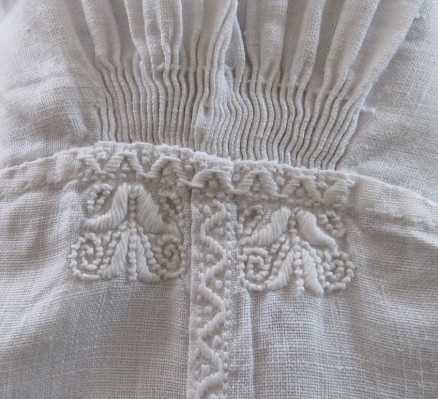Schwalm bodices are easily overlooked; this is not surprising since the bodice was worn under so many other costume pieces. Of the entire bodice, only the sleeves—with the their richly decorated cuffs—were really noticeable. The embroidery on the sleeve cuffs is very special and makes the bodice one of the most magnificent pieces of the festive Schwalm costume.
 The bodices were worn over an undershirt and harness. They were slim fitting, short waisted, and did not have any closures. The sleeves were disproportionately long.
The bodices were worn over an undershirt and harness. They were slim fitting, short waisted, and did not have any closures. The sleeves were disproportionately long.
 Often fine handwoven linen was used for making the bodices. A bodice was composed of the following parts: 2 sleeves, 2 gussets, 1 back, 2 fronts, 2 small side sections, and 1 neckline facing.
Often fine handwoven linen was used for making the bodices. A bodice was composed of the following parts: 2 sleeves, 2 gussets, 1 back, 2 fronts, 2 small side sections, and 1 neckline facing.
Most of the bodice components had straight edges, only the armscyes were slightly curved.
 Felled seams were used for sewing together the body sections, shoulder seams, closing sleeves, and inserting sleeves.
Felled seams were used for sewing together the body sections, shoulder seams, closing sleeves, and inserting sleeves.
 The center front edges were hemmed, and the edges of the neckline were finished with a facing.
The center front edges were hemmed, and the edges of the neckline were finished with a facing.
 All body sections were cut to size so that a selvage was at the bottom edge making hemming unnecessary. In this way additional layers of fabric in the waist area was avoided (and we have seen already the quantity of fabric at the waist with the multiple skirts).
All body sections were cut to size so that a selvage was at the bottom edge making hemming unnecessary. In this way additional layers of fabric in the waist area was avoided (and we have seen already the quantity of fabric at the waist with the multiple skirts).
 The fronts of the bodices were cut somewhat smaller than the back: so, the front edges did not reach the middle of the body.
The fronts of the bodices were cut somewhat smaller than the back: so, the front edges did not reach the middle of the body.
 On the right front of a bodice, the initials of the owner were embroidered using coloured thread and Cross stitches. Sometimes also narrow ornaments were embroidered between the single letters of the initials. (Such charted ornaments and letters can be found in the book Schwalm Crowns.)
On the right front of a bodice, the initials of the owner were embroidered using coloured thread and Cross stitches. Sometimes also narrow ornaments were embroidered between the single letters of the initials. (Such charted ornaments and letters can be found in the book Schwalm Crowns.)
 A small strip of fabric was inserted at the sides (between the front and back sections);
A small strip of fabric was inserted at the sides (between the front and back sections);
 the width of this strip was the same as the widest edge of the sleeve´s gusset.
the width of this strip was the same as the widest edge of the sleeve´s gusset.
 The sleeves, from the shoulder, were tapered down to the cuff.
The sleeves, from the shoulder, were tapered down to the cuff.
 The excess width of the sleeves at the shoulders was gathered down to 4 cm.
The excess width of the sleeves at the shoulders was gathered down to 4 cm.
 The tiny pleats were secured and stitched in place for about 1–1.5 cm with some rows of Running stitches. Curved line patterns decorate both a section of the seam adjacent to the pleats and a section of the shoulder seam. (More curved line patterns can be found in my publication Schwalm Curved Lines, Narrow Borders, and Ornamental stitches. Often additional small motifs were embroidered in the corners of the decorated seams.
The tiny pleats were secured and stitched in place for about 1–1.5 cm with some rows of Running stitches. Curved line patterns decorate both a section of the seam adjacent to the pleats and a section of the shoulder seam. (More curved line patterns can be found in my publication Schwalm Curved Lines, Narrow Borders, and Ornamental stitches. Often additional small motifs were embroidered in the corners of the decorated seams.
 The sleeve cuffs were decorated with embroideries. These developed variously and, depending on the status or wealth of the wearer, were more or less brilliant. There was always a whitework border, a Peahole hem, and needlelace. Often there was also a needle weaving hem, and sometimes a needle weaving hem in addition to Peahole hems can be found.
The sleeve cuffs were decorated with embroideries. These developed variously and, depending on the status or wealth of the wearer, were more or less brilliant. There was always a whitework border, a Peahole hem, and needlelace. Often there was also a needle weaving hem, and sometimes a needle weaving hem in addition to Peahole hems can be found.
The decorated sleeve cuffs are folded up to the top of the sleeves,
 the remaining unembroidered part is folded
the remaining unembroidered part is folded
 so that the bottom edge hangs around the elbow.
so that the bottom edge hangs around the elbow.
 The decorations of the sleeve cuffs will be discussed in a separate article. You can read it in my next post.
The decorations of the sleeve cuffs will be discussed in a separate article. You can read it in my next post.



Leave a Reply